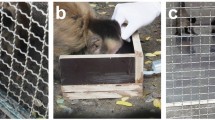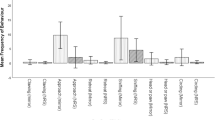Abstract
Group-living brown capuchins were given mirror-image stimulation as follows: (1) mirror 1 m away; (2) mirror attached to the cage-mesh; (3) angled mirrors creating a deflected image; (4) small mirror in the cage; and (5) small, transportable mirrors. The subjects were initially interested in the mirrors in each condition, but they generally habituated to them over the course of repeated presentations. Control (non-reflective) objects were attended to less than mirrors. Facial expressions occurred mostly in Condition 2, lateral and vertical head movements in Condition 3, reaching behind the mirror in Condition 2, looking obliquely into the mirror in Conditions 4 and 5. Despite these diverse conditions of exposure to mirrors, lasting for a total of over three months, no behaviours suggesting self-recognition were seen in the monkeys.
Similar content being viewed by others
References
Anderson, J. R., 1983. Responses to mirror-image stimulation, and assessment of self-recognition in mirror- and peer-reared stumptail macaques.Quart. J. Exp. Psychol., 35B: 201–212.
————, 1984. Monkeys with mirrors: Some questions for primate psychology.Int. J. Primatol., 5: 81–98.
————, 1986. Mirror-mediated finding of hidden food by monkeys (Macaca tonkeana andMacaca fascicularis).J. Comp. Psychol., 100: 237–242.
———— &F. Bayart, 1985. Les effets du miroir sur le comportement de macaques: Habituation, évitement et facilitation sociale.Biol. Behav., 10: 159–167.
———— &A. S. Chamove, 1986. Infant stumptailed macaques reared with mirrors or peers: Social responsiveness, attachment, and adjustment.Primates, 27: 63–82.
Bayart, F. &J. R. Anderson, 1985. Mirror-image reactions in a tool-using, adult maleMacaca tonkeana.Behav. Proc., 10: 219–227.
Benhar, E. E., P. L. Carlton, &D. Samuel, 1975. A search for mirror-image reinforcement and self-recognition in the baboon. In:Contemporary Primatology: Proceedings of the Fifth International Congress of Primatology,S. Kondo,M. Kawai, &A. Ehara (eds.), Karger, Basel, pp. 202–208.
Eglash, A. R. &C. T. Snowdon, 1983. Mirror-image responses in pygmy marmosets (Cebuella pygmaea).Amer. J. Primatol., 5: 211–219.
Gallup, G. G., Jr., 1970. Chimpanzees: Self-recognition.Science, 167: 86–87.
————, 1977. Absence of self-recognition in a monkey (Macaca fascicularis) following prolonged exposure to a mirror.Develop. Psychobiol., 10: 281–284.
————, 1982. Self-awareness and the emergence of mind in primates.Amer. J. Primatol., 2: 237–248.
————, 1987. Self-awareness. In:Comparative Primate Biology, Vol. 2B: Behavior, Cognition, and Motivation,G. Mitchell &J. Erwin (eds.), Alan R. Liss, New York, pp. 3–16.
———— &M. K. McClure, 1971. Preference for mirror-image stimulation in differentially reared rhesus monkeys.J. Comp. Physiol. Psychol., 75: 403–407.
————,L. B. Wallnau, &S. D. Suarez, 1980. Failure to find self-recognition in mother-infant and infant-infant rhesus monkey pairs.Folia Primatol., 33: 210–219.
Hall, K. R. L., 1962. Behaviour of monkeys towards mirror-images.Nature, 196: 1258–1261.
Itakura, S., 1987a. Mirror guided behavior in Japanese monkeys (Macaca fuscata fuscata).Primates, 28: 149–161.
————, 1987b. Use of a mirror to direct their responses in Japanese monkeys (Macaca fuscata fuscata).Primates, 28: 343–352.
Lethmate, J. &G. Dücker, 1973. Untersuchungen zum Selbsterkennen im Spiegel bei Orang-Utans und einigen anderen Affenarten.Z. Tierpsychol., 33: 248–269.
MacLean, P. D., 1964. Mirror display in the squirrel monkey (Saimiri sciureus).Science, 146: 950–952.
Masataka, N. &H. Fujii, 1980. An experimental study on facial expressions and interindividual distance in Japanese macaques.Primates, 21: 340–349.
Menzel, E. W., Jr., E. S. Savage-Rumbaugh, &J. Lawson, 1985. Chimpanzee (Pan troglodytes) problem solving with the use of mirrors and televised equivalents of mirrors.J. Comp. Psychol., 99: 211–217.
Parker, S. T. &K. R. Gibson, 1977. Object manipulation, tool use and sensorimotor intelligence as feeding adaptations in cebus monkeys and great apes.J. Human Evol., 6: 623–641.
Platt, M. M. &R. L. Thompson, 1985. Mirror responses in a Japanese macaque troop (Arashiyama West).Primates, 26: 300–314.
Suarez, S. D. &G. G. Gallup, Jr., 1986. Social responding to mirrors in rhesus macaques (Macaca mulatta): Effects of changing mirror location.Amer. J. Primatol., 11: 239–244.
Visalberghi, E., 1988. Responsiveness to objects in two social groups of tufted capuchin monkeys (Cebus apella).Amer. J. Primatol., 15: 349–360.
Weigel, R. M., 1979. The facial expressions of the brown capuchin monkey (Cebus apella).Behaviour, 68: 250–276.
Westergaard, C. G. &D. M. Fragaszy, 1985. Effects of manipulatable objects on the activity of captive capuchin monkeys (Cebus apella).Zoo Biol., 4: 317–327.
———— & ————, 1987. The manufacture and use of tools by capuchin monkeys (Cebus apella).J. Comp. Psychol., 101: 159–168.
Author information
Authors and Affiliations
About this article
Cite this article
Anderson, J.R., Roeder, JJ. Responses of capuchin monkeys (Cebus apella) to different conditions of mirror-image stimulation. Primates 30, 581–587 (1989). https://doi.org/10.1007/BF02380884
Received:
Accepted:
Issue Date:
DOI: https://doi.org/10.1007/BF02380884




